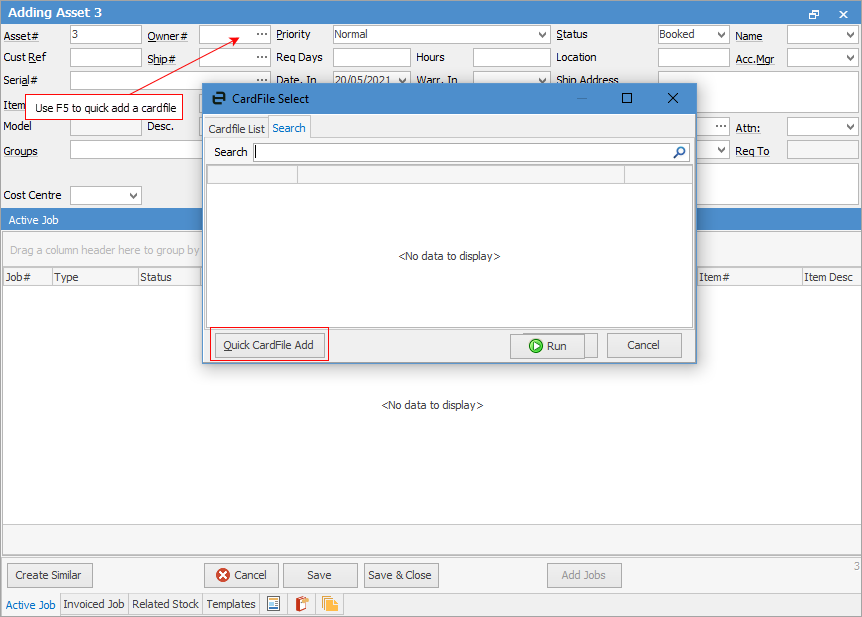
On the ribbon, go to Assets > Add Asset.

|
Some letters in the field names within the header are underlined, eg. Cust#. Using Alt+ the underlined letter will jump to the field beside that heading. |
|
Jim2 automatically adds a unique asset number (which can be changed), records the date in and defaults the Status to Booked. |
Jim2 places the cursor at the appropriate fields that the user is required to complete. The Enter key will move the text cursor to the next user input field in the job entry path. The path follows:
▪Asset# – this is populated by Jim2 but can be changed.
▪Owner# – select the customer card code the Asset is for.
▪Customer Ref# – enter a customer reference, if desired.
▪Ship# – select the ship card, if different to the Owner#.
▪Item# – select the Item for this asset.
▪Desc. – this field automatically populates from the Item, but can be edited.
▪Serial# (if required)
▪Comment – enter any comments relevant to this asset.
Select an Owner (customer) in one of the following ways:
▪Start entering the customer name. Jim2 intuitive type will begin to pre-empt the choice of names from the card code based on what is being entered.
▪Click the ellipsis [...] beside the Cust# field to display the full list of customers, then choose from the list.
▪If there is no cardfile for the customer, when in the Cust# field use F5 select Quick CardFile Add to enter a new cardfile. This can then be used on the current asset.

|
When accessing the CardFile Select screen via the ellipsis, the Search tab will automatically be selected if current Cust# is the default as assigned by Tools > Options > Job > Cust#. |
Jim2 provides the ability to use one customer contact for billing purposes and another customer contact for shipping purposes. Select a billing card in the Owner# field and a different card in the Ship# field.
Enter a customer reference (for example, name of the person who requested the job, or a specific number the customer supplies) in the Customer Ref# field.
|
Note: A Cust Ref# must be entered before invoicing is allowed. |
This alpha/numeric reference should be supplied by the customer so that they can match this job with their own internal procedures, personnel, purchase orders or work orders. If multiple jobs are required for the same reference number (work order), use a Job List to monitor the progress of the work order, and choose to invoice each job separately or all on one invoice – depending on the customer's requirements.
Select the appropriate Priority and Status, and choose the Name and Acc.Mgr of the users responsible for the asset.
Select the Item (if required) that is attached to this Asset (remember Item is the prime objective of a job) and the Desc. fieldS will default to the text description as set up in that Item record.
Items can have stock such as status sensitive tests or checks apply to them. When entering an Item where such stock applies, that stock (with a stock status) will automatically default into the stock grid for every job, unless the Auto Add box is not ticked on the Item record.
Enter the serial number (if required) in the Serial# field.
Req Days/Hours can be entered. This should reflect the planned response time for service, etc.
Date.In will show the date the Asset was entered and is automatically recorded by Jim2. This can be changed if required. Date Out is an optional field.
Location allows you to enter the precise location of the asset, ie. Front Office, Reception, etc.
The Ship Address will populate from the Ship# card.
The Request #, Attn., Request By and Req To fields relate to the way a request for meter reads is performed, and is used more by managed print services.
Select any Groups the asset is included in.
Cost Centre is usually used for large customers that may have a number of assets in one area of the business, ie. Accounts.
The Comment grid allows you to enter any other information you may require relating to this asset.
|
You can also use the Create Similar button on an open Asset to create a similar asset, then make changes to suit. |
How to

